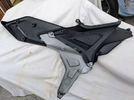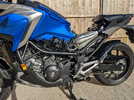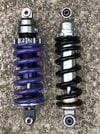oldwisedude
Member
- Joined
- Sep 29, 2023
- Messages
- 32
- Reaction score
- 28
- Points
- 18
- Location
- West Sussex, England
As we know, after 2021 Honda lowered the ride height of the NC750X, changed side panels, shortened the suspension travel plus other styling changes. I will be upgrading my rear shock next week so wanted to understand what is entailed. The most difficult part is accessing the top fixing bolts. I attempted to remove what seemed like the appropriate side panels but these are fiendishly interlinked with all the other panels and cannot be removed in isolation. So I could not get convenient side access to the top fixings. The lower fixings are easy but I wanted to solve the top fixing access problem first, otherwise I would delegate the job to my Honda dealer.
You either need a centre stand or some stable lifting equipment to ease the weight from the rear wheel but still leave it resting on a thin block of wood or just touching the ground. All bolts are fitted from the left side, with nuts on the right side. The nuts are 17 mm A/F, bolts are 14 mm A/F and 8 mm Allen socket.
I could barely see the top fixings - they are so tucked away. Getting head, eye and torch in position and then locating a spanner is very challenging. The RH top nut needed the longest 17 mm combination spanner that I had, hooked up to a similar ring spanner to give it extra leverage. I also alternated with a fine-toothed 3/8 drive ratchet and small socket. The LH side 8 mm Allen bolt could be reached (just) from the rear, accessing above and around the chain area, provided you have small hands (I had to removed my rear hugger to improve access).
Needless to say you can barely get a 30th of a turn on anything, because you haven't room to swing the spanners. (On the production-line Honda would undoubtedly fit the shock before the side panels were fitted). So it means a tiny bit using the ring, then a bit with the socket, then a bit with an open-ender, then back to the ring and so on. The LH 8 mm Allen bolt was difficult to locate, since with only six flats available I had to let the RH self-locking nut rotate the bolt until I could locate the Allen. What a rigmarole! But heroically I eventually succeeded, without damaging any nuts or bolts.
Once I proved I could remove the top bolt I then removed the bottom fixings (easy job), dropped the shock out and greased the pivots at the same time.
Much of the time is initially spent gathering a selection of tool options, of which I have plenty. The top shock bolt removal is extremely tedious but it can be done in situ without panel removal but the job needs immense patience. (It is easier on pre 2021 models)
(see later posts - the centre side panels can in fact be removed separately and easily, making access to rear shock bolts very easy)
You either need a centre stand or some stable lifting equipment to ease the weight from the rear wheel but still leave it resting on a thin block of wood or just touching the ground. All bolts are fitted from the left side, with nuts on the right side. The nuts are 17 mm A/F, bolts are 14 mm A/F and 8 mm Allen socket.
I could barely see the top fixings - they are so tucked away. Getting head, eye and torch in position and then locating a spanner is very challenging. The RH top nut needed the longest 17 mm combination spanner that I had, hooked up to a similar ring spanner to give it extra leverage. I also alternated with a fine-toothed 3/8 drive ratchet and small socket. The LH side 8 mm Allen bolt could be reached (just) from the rear, accessing above and around the chain area, provided you have small hands (I had to removed my rear hugger to improve access).
Needless to say you can barely get a 30th of a turn on anything, because you haven't room to swing the spanners. (On the production-line Honda would undoubtedly fit the shock before the side panels were fitted). So it means a tiny bit using the ring, then a bit with the socket, then a bit with an open-ender, then back to the ring and so on. The LH 8 mm Allen bolt was difficult to locate, since with only six flats available I had to let the RH self-locking nut rotate the bolt until I could locate the Allen. What a rigmarole! But heroically I eventually succeeded, without damaging any nuts or bolts.
Once I proved I could remove the top bolt I then removed the bottom fixings (easy job), dropped the shock out and greased the pivots at the same time.
Much of the time is initially spent gathering a selection of tool options, of which I have plenty. The top shock bolt removal is extremely tedious but it can be done in situ without panel removal but the job needs immense patience. (It is easier on pre 2021 models)
(see later posts - the centre side panels can in fact be removed separately and easily, making access to rear shock bolts very easy)
Last edited:





